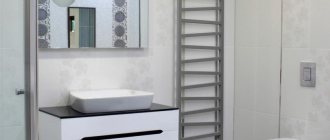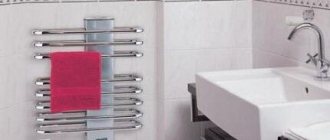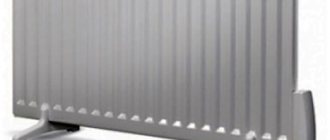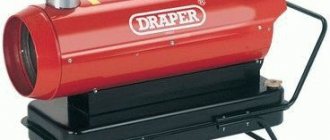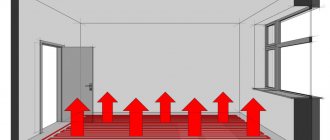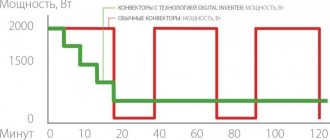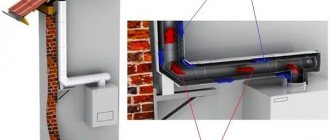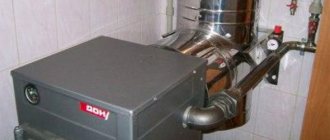In the absence of centralized heating in the bathroom, the issue of heating arises very acutely, it is especially relevant in the cold season. It is important to choose the right heater for your bathroom. Firstly, a sharp change in temperature during and after swimming can negatively affect your health. Secondly, the lack of heating and regular evaporation of hot water contribute to the development of fungus and mold, which also poses a threat to the human body.
The heater in the bathroom must be adapted to work in conditions of high humidity
Requirements for heating equipment
Appliances for heating bathrooms must meet certain requirements:
- Resistant to temperature changes.
- Complete safety when working in damp areas, as well as when exposed to splashes.
- The materials from which heating devices are made must be resistant to corrosion.
- Compactness, since most often the size of bathrooms is small.
- Power that is enough to heat the desired room.
- Aesthetic appearance.
Which heaters are best installed in the bathroom?
Manufacturers of heating devices offer a wide range of products that meet the safety and ergonomic requirements for the bathroom. Steam heating is a budget type suitable for wet rooms.
Heating batteries
There are several options for energy-saving bathroom radiators:
- aluminum;
- cast iron;
- steel;
- heated towel rail;
- bimetallic.
Aluminum radiators have a pleasant appearance and are easy to install. When contacting hot water, the metal releases gas, so additional gas outlet pipes are installed.
Aluminum sectional batteries heat up quickly and cool down quickly
Domestic-made cast iron radiators are considered a budget type of equipment. Modern designer radiators not only heat, but also decorate the room. These models are expensive. Advantages - long service life, maintain heat for a long time during an emergency shutdown. Disadvantage: heavy weight, long initial heating time.
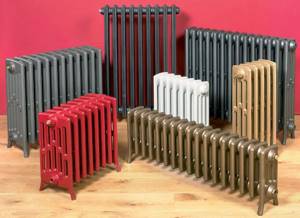
The modern design of cast iron radiators can decorate a room
Steel batteries have an attractive appearance; they are manufactured individually according to customer sizes. Radiators have high heat transfer. Lightweight and easy to install.

Steel radiators have a long service life
Heated towel rails do not warm up the bathroom well. They maintain positive room temperature. They are not used as an independent type of heating device. Experts recommend combining a heated towel rail with other types of heating, such as “warm floor” or “hot baseboard”.
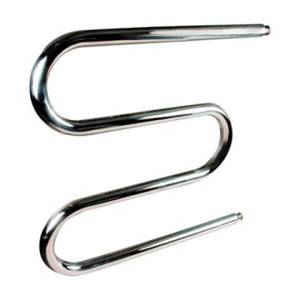
The heated towel rail is connected to a general heating system or to a hot water main.
Bimetallic radiators consist of 2 metals, aluminum and copper. Their low weight makes it easy to install the equipment; they maintain the required level of moisture in the room.
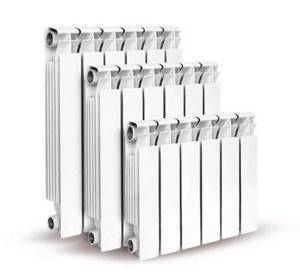
Bimetallic batteries heat up quickly and cool down quickly
Oil radiator
The most common type of heaters among consumers. The oil radiator is equipped with a moisture-resistant metal housing with an electric spiral. The internal space is filled with mineral or synthetic oil.
The oil heater consists of finned sections. The heat transfer of the device depends on their quantity. The disadvantage of the device is slow heating.

Modern manufacturers provide models of oil-filled heated towel rails that are compactly installed in the bathroom
Advantages of an oil cooler:
- safe high coolant temperature (600 0C);
- silent operation;
- mobility;
- heating temperature switch.
Infrared heater
A distinctive feature of the device is that it is not the air that is heated, but the objects in the room. The infrared heater for the bathroom consists of a quartz emitter and a heat-insulating plate, which heats up to 260 0C.
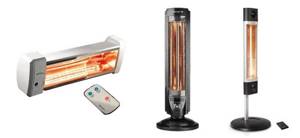
The infrared heater can be wall, floor and ceiling mounted
Convective-infrared modular heaters consist of a heating element containing a nichrome thread filled with powder. The modular design allows you to change the power. Using a thermostat, the heating temperature is changed.
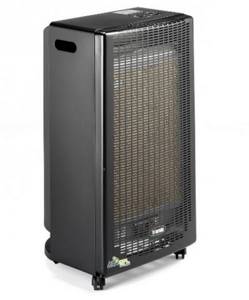
The module meets safety requirements and is suitable for the bathroom
Panel electric convectors are a type of IR heater for the bathroom. Aesthetic panels are produced as an imitation of natural stone or with a glossy, decorative, colored or plain coating.
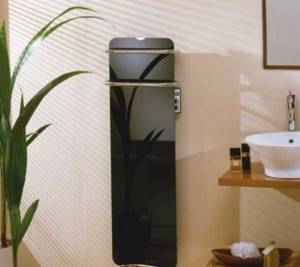
Modern models of panel infrared heaters can decorate any interior
Electric convector
The wall-mounted electric bathroom heater consists of a metal body and a heating coil. They produce wall and floor models. The power of the device reaches 2500 W.
Manufacturers produce thin models for bathrooms with high heat transfer with a quartz plate. Convector advantages:
- safety;
- waterproof housing;
- silent operation;
- mobility;
- ease of installation and maintenance;
- economical;
- aesthetics of execution.
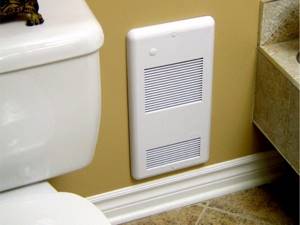
The heater body warms up to 650C and does not burn the body
Attention! Experts highlight the disadvantage of the device: silent models have low heat transfer, so they slowly warm up the room.
Models with a built-in fan to disperse air and increase heating speed are noisy and consume a lot of electricity. A convector without a fan is considered an energy-saving device.
Heat fan
This type of electric heater for the bathroom is a budget one. Features a high heat transfer rate. A small bathroom space warms up quickly. Device power 2000-2500 W. Typically, models are small in size and easy to carry.
The device consists of a housing, a heating coil and a fan. The latter transmits heated air to the bathroom. The heating element heats up to 800 0C.
The lightweight body of the product allows you to install the fan heater on furniture with a flat surface. Place it on the floor and hang it from the walls.
They produce wall and ceiling models; they have greater heat transfer power, but are more expensive. Such products are equipped with deflectors that change the direction of the air. These devices are most suitable for the bathroom, because their housing is more protected from dripping.
Ceiling models prevent the formation of condensation, which protects the cladding from destruction.
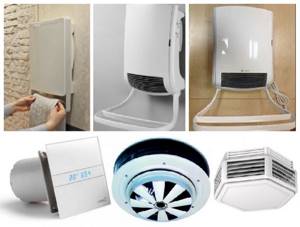
The heating element of the device is spiral, tubular or ceramic
For the bathroom, models with a ceramic heater are installed. In order to increase heat transfer, the fan heater housing is decorated with an aluminum grille. These devices reduce their electricity consumption as they heat up. The quality of the device increases its value.
Inverter air conditioner
This is a good option for an electric heater for the bathroom on the wall. The device works by drawing in fresh air from the street, heating it to the required temperature and transferring it into the room. This work is performed by an inverter pump. The split system consists of a wall module, remote control and external fan.
The heater is an environmentally friendly product because it does not produce harmful substances during the process.
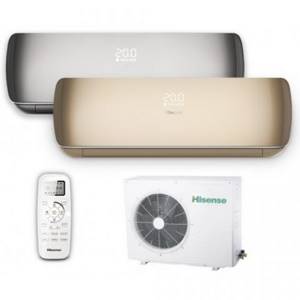
The inverter air conditioner is a wall-mounted split system
Experts highlight the advantages of the device:
- combination of heater and air conditioner;
- high efficiency;
- works in frosts down to - 20 0C;
- aesthetic appearance;
- moisture-resistant housing;
- environmental friendliness.
The disadvantages include the high cost of the device.
Pros and cons of wall heaters
The advantages of such devices include the following characteristics:
- Highly environmentally friendly wall-mounted electrical appliances. All considered types of wall heaters, as a rule, are made of high-quality materials that, when heated, do not become a source of toxins and other harmful substances.
- Affordable price.
- Fire safety and moisture resistance. As a rule, all bathroom heating devices are capable of operating in high humidity conditions. Thanks to the thermostat, they turn off and turn on again in time.
- Cost-effective and efficient. The types of wall heaters under consideration heat the room quickly enough and at the same time consume little electricity.
- Aesthetics and attractive appearance. All modern types of wall heaters look quite neat and are easily combined with any interior style.
- Compactness. Since these devices are wall-mounted, they require absolutely no space, but still do their job perfectly.
- Simplicity and ease of use. Absolutely all modern heater models are equipped with an automatic heat regulator. Some more expensive models are also equipped with a timer, Restart function, remote control and other convenient functions.
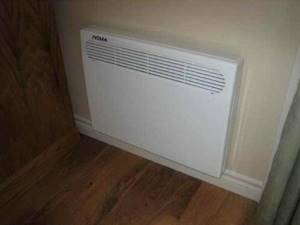
As for the disadvantages of these devices, they are generally absent. The only thing that should be noted is that in houses where power is often cut off, the use of such heaters is irrational.
The best convector heaters for the bathroom
The principle of operation of the convector is to start the circulation of hot and cold air naturally (hot air rises to the top, and cold air is drawn in from below). This ensures uniform heating in the room so that taking a bath becomes more comfortable, regardless of where the heater is located.
Noirot Spot E-5 Plus 1000
Rating: 4.9
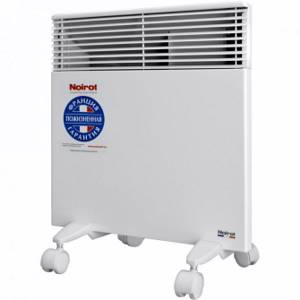
This is a powerful heater, convector type, generating 1000 W, which is enough for a spacious bathroom with an area of 10-15 m². The model is equipped with electronic control and thermostat. There is a digital screen and temperature control buttons in the upper right corner. Users in their reviews share that it is very easy to understand the settings and you can master everything without instructions. The heater is mounted on the wall in the bathroom, but it comes with legs (at an additional cost), so the convector can be made mobile. The heater is capable of operating in three modes. Among the protective functions there are: shutdown when overheating and maintaining a positive temperature in case users leave home for a long time.
Buyers in the reviews like the heater for its ratio of size and heated area. With dimensions of 42x44x8 cm, it is enough for a huge room of 15 m². If the convector is placed on the wall, it will not attract attention and you can completely forget about its existence.
Advantages
- high-quality French assembly;
- safe operation due to the waterproof housing;
- bright display;
- easy to understand controls.
Flaws
- high price;
- When you first turn it on, you hear an unpleasant smell.
Nobo NFK 4S 07
Rating: 4.8

In second place is a heater with dimensions of 62x40 cm, equipped with a snow-white panel with three slots in the upper part, accelerating the release of hot air. The bathroom model consumes 750 W per hour and is designed for a room area of up to 11 m². It has electronic controls, but no screen. The temperature is adjusted using a slider on the back of the case, under which there is a scale with degrees. The heater operates in two modes. The kit includes a bracket for mounting to the wall. Installation on legs is possible as an option. If the device is turned over, the fall protection will work. It also has shutdown functions in case of overheating and maintaining a positive temperature in cold weather.
The model attracted experts with its ultra-thin 55 mm case. Competitors with similar power have heater thicknesses that are usually 70-100 mm. With a parameter of 5.5 cm, the convector protrudes minimally from the wall, which saves usable space in the bathroom and reduces the likelihood of accidentally catching your knee on it.
Advantages
- simple installation with 4 dowels;
- built-in thermostat and electronic control;
- simple temperature adjustment according to the drawn scale;
- thin body.
Flaws
- legs are purchased separately;
- high price;
- no display.
Types of heating devices
Today on sale you can find a large assortment of heating devices that meet all conditions; all that remains is to make the right choice.
Heating batteries
These can be either heated towel rails or ordinary radiators, which are installed in rooms and kitchens:
- Heated towel rail with water operating principle. Ideal for equipping small spaces. They are unlikely to be able to heat a large space. A water heated towel rail will only be relevant when there is hot water in the house.
- An electric heated towel rail is obviously a convenient device, but it requires significant financial investment.
- Aluminum radiators have high heat transfer. When installing such batteries, be sure to install gas outlet tubes, since aluminum emits a small amount of gas when in contact with hot water.
- Cast iron batteries are a good budget option that also has a long service life. Such devices are resistant to mechanical damage. The disadvantages include quite a lot of weight and low heat transfer.
- Steel radiators have high heat transfer. Their installation is simple, and their service life is very long.
- Bimetallic structures are the most expensive option for heating equipment.

Oil radiator
Undoubtedly, an oil radiator can be found in almost every home or office. This type of heating device has won the trust of buyers due to its mobility and relatively low price. The body of the device is metal, inside it there is an electric coil. The rest of the space of the heater is filled with mineral oil (for more details, see the article about the design features of oil heaters).
When you turn on the device, the coil heats up, the heat from it is transferred to the oil, which boils over time. And this, in turn, heats the entire body. This is how the room is heated.
Most of these devices consist of sections, and the more there are, the higher the heat transfer.
Radiators are equipped with a regulator with which you can control the degree of heating of the device.
Advantages of oil heating devices:
- high degree of heating;
- complete security;
- mobility (easy to move from room to room due to the presence of wheels);
- silent operation;
- do not burn oxygen, are especially relevant if they are placed in a small bathroom;
- presence of a regulator.
Flaws:
- slow heating compared to other devices;
- some models may emit an odor;
- require a certain amount of space in the room.

Infrared heater
This heater is an economical heating device that is placed on the wall or ceiling.
The infrared heater is a heat-emitting plate and a quartz emitter. The plate can heat up to 260 degrees.
The principle of its operation is as follows: the device heats the air to a certain temperature, after which it automatically turns off. When the temperature begins to decrease, the heater turns on automatically (for more details, see the article on the operating principle of a heater with infrared radiation).
A plus is that an infrared heater saves space, which residents so desperately need when designing a bathroom. And also the fact that it warms up not only the air, but also the walls, floor and interior items, the emanating heat from which helps to maintain comfort in the bathroom longer.
The infrared rays of the device can be directed to any point in the room, which makes it possible to heat only that part of the room where it is necessary.
The advantages of this type of heating equipment are:
- security;
- reliability;
- efficiency;
- presence of a thermostat;
- opportunities to save space, since the device does not take up space on the floor;
- small sizes;
- large selection of models.
The only downside worth noting is that the cost of an infrared heater cannot be called low. But if you spend money once, the device will definitely pay for itself in the future.
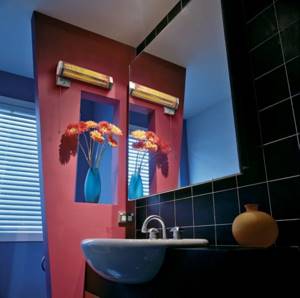
Electric convectors
Convector heaters are most often used to insulate office premises, and sometimes apartments. They have a power of up to 2500 watts, which is enough to heat a room of 25 sq.m. The shape of the device is rectangular, inside it there is a heating coil that warms up the incoming cold air. Electric convectors are either hung on the wall or installed on the floor. Maximum efficiency can be achieved by installing them as close to the floor as possible.
Convectors have undoubted advantages:
- silent operation;
- safety;
- mobility;
- quick heating of the room;
- ability to maintain temperature for a long time;
- moisture-resistant housing;
- the ability to connect several devices;
- economical waste of electricity;
- stylish design.
Despite all the advantages, it is necessary to note a significant disadvantage of such structures. To speed up the heating of the room, such devices are equipped with a fan, due to which the operation of the device cannot be called silent.
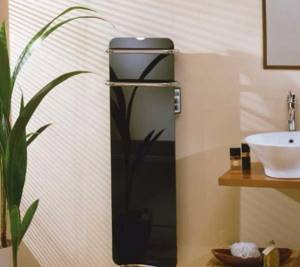
Liquid heated towel rails
Since any bathroom needs a heated towel rail, it is necessary to choose this item wisely. The traditional type of liquid heated towel rail is a curved pipe that connects to the home's water system. Thus, you can get a heating device that not only warms up damp things, but also maintains the optimal temperature in the room.
The heat transfer from the dryer is not too great, and therefore the design does not include radiating surfaces or ribs that form upward heat flows.
A heated towel rail is an ordinary curved pipe, the diameter of which is comparable to that of a water pipe. The device can also be a ladder consisting of a certain number of elements. Hot water will flow inside the pipe, with the help of which a towel or things can be dried in a fairly short time, while creating a comfortable temperature inside the bathroom.
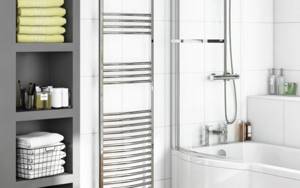
Liquid heated towel rails for heating the bathroom
From this we can conclude that the equipment is very useful in winter, but it is worth noting that when cold water flows through the pipes, the heated towel rail becomes useless - no heat will be received. You also need to know that such devices often become corroded. The fact is that tap water contains oxygen, and because of it, this process accelerates. When the hot water supply is turned off, the cold pipe will become covered with condensation, which can soon cause corrosion build-up.
Inverter air conditioner
The operating principle of an inverter air conditioner is simple. The device sucks air from the street, heats it and transfers it to the apartment. This is possible thanks to the inverter pump. The advantages of such a device are that it can act as both a heater and an air conditioner, and that it has the highest efficiency compared to other equipment. And the main advantage of the inverter device is that it can operate even at very low outside temperatures, about 20 degrees.
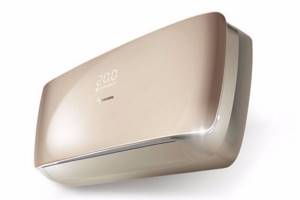
Ceramic
This heating device can be powered by electricity or gas. The outer part is made of metal. The plate-shaped heating part is made of many ceramic parts. This design allows you to heat large rooms quickly and evenly. They are usually installed either under the window sill, that is, closer to the floor, or high up, near the ceiling. Their design allows them to fit into any interior. Some samples can be controlled remotely. Their compactness and ease of installation allows them to be moved from one room to another.
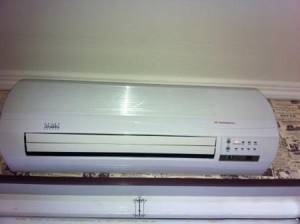
Heat fan
A fan heater is the simplest type of heating device, which can be purchased at a fairly low price. Using a fan, you can insulate a room as quickly as possible in cold weather. That is why this device is often purchased for the bathroom.
Heat fan power varies from 2000 to 2500 W. The equipment has different sizes, but is distinguished by its compactness. The fan heater is also very light, and therefore can be mounted on any wall surface or simply placed on the floor. The equipment consists of a plastic case, an internal fan, and a coil that will heat up during operation. The heat received from the coil is transferred outside through the fan.
All this suggests that the advantages of a bathroom heating device include small size and light weight, as well as simple controls. But there are also certain disadvantages - noise during operation, an unpleasant odor released when a large amount of dust accumulates on the spiral.
Cable heated towel rails
A cable heated towel rail is equipment with a built-in cable, which resembles the one found in a heated floor system. But unlike the “floor”, electricity consumption is noticeably lower.
The cable version has a more original design than other types of bathroom heaters. This type of equipment is cheap because there is no need for increased tightness compared to the liquid model.
The cable type is also very easy to place at the workplace, since there is no need to connect heating elements to it, which are usually located at the bottom of the case. This suggests that the equipment is located in both a diagonal and vertical plane. The heated towel rail heats up very quickly, but at the same time it cools down quickly after switching off - this is a minus.
Water heating radiators made of aluminum, copper
The radiator is made of pure aluminum or copper-aluminum. This design weighs much less than “antique” cast iron products, looks more beautiful, and due to its special structure, stabilizes the air humidity in the bathroom.
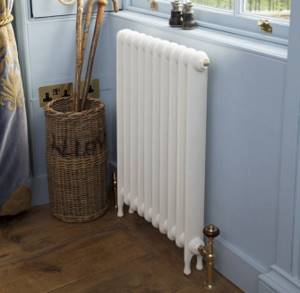
These radiators look quite attractive and fit well into the interior of the bathroom.
Due to the fact that the radiator warms up quickly, the room is also heated in less time. The price of the product is relatively low, installation also does not cause problems.
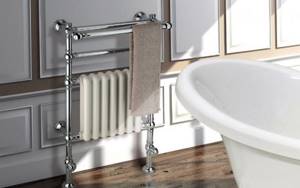
The heating radiator can be combined with a heated towel rail; this model is included in the hot water circuit and operates independently of heating
Panel heaters
Panel electric convectors heat rooms of different sizes, their power is 2500 W. The design is made of an iron body with a heating coil inside. Cold air, passing through the heating area, becomes warm and warms the radiator to the desired temperature. The device is mounted on the wall, but is more effective when installed on the floor. The best models are those that have a ceramic heating element - they are not able to “burn” air. For wet rooms, special designs have been created that can work in such conditions.
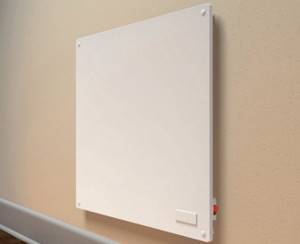
The undeniable advantage of electric panel heaters is their compactness and the ability to quickly install
Advantages of the product: it makes almost no noise, easily moves to the right place, quickly warms up the room, is safe, and has an attractive appearance. Disadvantage - a built-in fan is required (which creates noise), which speeds up the process of insulating the room. There are also film convectors that look like a roll and are placed on a door or wall.
How to choose a bathroom heater
So, let's start with tips on how to choose a heater for a bathroom, which will help you understand the main characteristics of the product:
- Power and heating area
. Two inextricably linked parameters. The higher the power, the larger the room you can heat with such a device. The calculated value for additional heating (when there is a coil from a centralized system) is 100 W per 1 m². If we are talking about a room that has no heating at all, then the power is selected according to the scheme 150 W per 1 m². - Dimensions.
The dimensions of the heater can be from 30x30 cm to 150x40 cm, which is important to consider based on the availability of free space in the bathroom, otherwise it will be impossible to turn around in the room. - Installation method
. The heater can be installed on the floor, wall or ceiling. Here again everything depends on the size of the room and its clutter. Ceiling models do not take up any extra space at all, but are subject to greater exposure to steam, and therefore corrosion occurs faster. - Moisture resistance
. The housing seal level varies from IP22 to IP65. The minimum value means that the housing should not be splashed with water. Maximum means that the heater can be sprayed with jets of liquid at any angle. This protects the electrical appliance from damage and also increases the safety of use in the bathroom. - The presence of a thermostat
. The built-in module allows you to maintain the set air temperature and turns off once it is reached. This saves energy. Without it, the heater will be constantly on. - Type of control
. Mechanical control is simpler, but operates with a greater error in heating degrees. Electronic control is more complex, but is capable of maintaining the set temperature with maximum accuracy. - Additional functions and equipment
. Overheat protection will prevent the device from catching fire. The display allows you to visually monitor the temperature and entered settings. Tip-over protection will turn off the power if the unit is accidentally dropped. Devices with Wi-Fi can be turned on in advance via your smartphone so that the bathroom is warmed up when you arrive home. Frost protection will help maintain a positive temperature in the room and prevent communications from freezing. Locking the buttons will prevent children from changing the settings. The timer is convenient for turning off automatically so you don't have to think about it when you leave the bathroom.
Now you know the basic criteria for choosing a heater for use in the bathroom. Consideration of specific models selected by experts based on characteristics on the analytical portal https://rankquality.com/radiators/ and reviews will help you find a suitable option for a specific location.
Other ways to heat bathrooms
In addition to the listed methods of heating wet rooms, there are the following:
- warm floor;
- hot baseboard;
- electric heated towel rail.
Warm floor
Heated floors are installed in 2 ways: using electric plates or water heating. The first are a zigzag cable to which wires are connected. This plate is laid on the prepared subfloor surface and ceramic tiles are laid.
For water heated floors, a flexible metal-plastic pipe is used, which is laid in a loop on the rough surface and covered with tiles or other facing material.
The benefits include:
- comfort;
- reliability;
- does not take up space;
- no additional heating required;
- secure system.
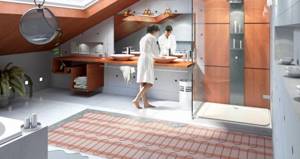
Manufacturers provide a 15-year warranty on the operation of electric heated floors.
The thermostat allows you to heat the floors to the set temperature. The room warms up evenly and does not burn your feet. This type of heating is ideal for the bathroom.
Hot baseboard
The device is installed instead of a regular baseboard; it does not differ from the usual decor, but there is a heating element inside it.

Electric plinth sections are made of porous stones
The device is installed in places of high humidity or under a towel holder. The heater does not take up additional space and warms the room well.
Electric heated towel rail
These devices are distinguished by coolant:
- liquid;
- cable
Liquid heated towel rails are designed like an oil heater. Synthetic or mineral oil is filled inside, which is heated by a heating element. This device is heavy, so before attaching it, the wall is checked for reliability and, if necessary, strengthened.
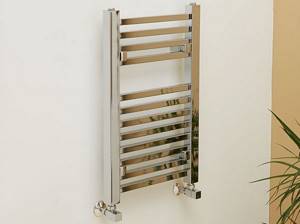
The design of the liquid heater does not contain rotating elements
The power of the device is 300-600 W, the surface of the device heats up to 70 0C.
Cable heated towel rails consist of a body and a heating wire. The surface protects the electrical wire from moisture and allows manufacturers to produce models with rotating holders.
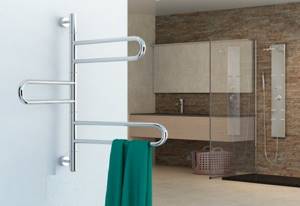
The low weight of the device allows it to be installed in any convenient place
Device power 60-120 W. The air temperature reaches 650 °C. The economical device heats up quickly and cools down quickly.
The best infrared heaters for the bathroom
Equipment with infrared rays heats the person directly, so the heat begins to be felt immediately after switching on. There is no need to wait for the bathroom to warm up.
Timberk TCH A03 800
Rating: 4.9
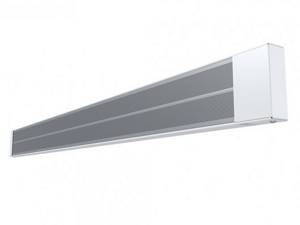
This is a heater for use in the bathroom that generates infrared heat from two elongated blocks with an increased area due to the cellular structure. The panel is designed for ceiling installation and the placement height is allowed up to 2.5 m. With a power of 1000 W, the heater is capable of heating a bathroom with a room area of up to 12 m². There are no buttons or switches on the case, which increases its tightness and protection from steam. But the device cannot regulate the temperature on its own; you will need to purchase an additional thermostat. Judging by the reviews, users like that the device quickly warms up the room. The ceiling heater has a directional effect, so it can be placed as far as possible from the area where steam and condensation rise, but installed at an angle so that the heat rays shine directly on the user.
In our opinion, the product outperforms other ceiling models in terms of the thinness of the body. The panel height is 45 mm. This facilitates neat placement on the ceiling so that nothing sticks out on it.
Advantages
- silent operation;
- does not dry out the air;
- quickly warms up the room;
- Installation at an angle is allowed.
Flaws
- large dimensions 164x14x4.5 cm;
- only one operating mode;
- weighs 6.7 kg;
- no thermostat.
How to choose a good convector and not go wrong
There are some rules that should be followed when choosing a quality device that, if used properly, will last for many years:
- You need to decide on the cost of the device. Prices for models from different manufacturers vary significantly. The market offers a variety of cost options - both budget options and more expensive ones. The best device, according to most users, is the Noirot Spot EIII. This model is distinguished by its high power of about 1500 watts and attractive design. The average cost is about 5,000 rubles. This is the best option for the bathroom. This manufacturer of heating equipment is recognized as a leader in the mid-price category.
- Think about the installation location in advance. You can hang the device on the wall, install it on the floor and move it to a convenient place as needed. For a bathroom, it is better to give preference to a wall-mounted unit, as it will not interfere and take up a lot of space.
- Another important point is the types of device. There are two types of electric convectors : liquid and dry. For example, if you need to heat the entire apartment, then a liquid device is better suited, since its powerful radiator is located in the working fluid. When choosing a device for the bathroom, it is recommended to choose a dry device, since we need to heat a small area.
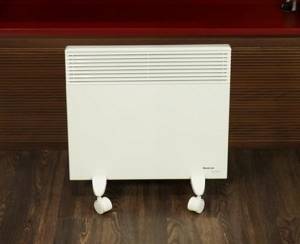
Rating of the best bathroom heaters
| Nomination | place | Name of product | price |
| The best convector heaters for the bathroom | 1 | Noirot Spot E-5 Plus 1000 | 9 790 ₽ |
| 2 | Nobo NFK 4S 07 | 8 470 ₽ | |
| 3 | Electrolux ECH/AG2-1000 T | 1 990 ₽ | |
| 4 | Ballu BEC/ETMR-1000 | 2 144 ₽ | |
| 5 | Timberk TEC.PF10N DG 1000 IN | 2 812 ₽ | |
| 6 | Thermex Frame 1000E Wi-Fi | 4 110 ₽ | |
| The best infrared heaters for the bathroom | 1 | Timberk TCH A03 800 | 2 182 ₽ |
| 2 | Ballu BHH/M-09N | 590 ₽ | |
| 3 | STN NEB-M-NSt 0.7 (mChk) | 3 199 ₽ | |
| 4 | Thermal phone ERGNA - 0.7/220 (p) | 1 950 ₽ | |
| 5 | Peony Thermo Glass P-06 | 4 184 ₽ | |
| 6 | Ballu BIH-S2-0.6 | 2 366 ₽ | |
| The best baseboard heaters for the bathroom | 1 | REDMOND SkyHeat 7002S | 2 490 ₽ |
| 2 | STN R-1T | 2 945 ₽ |
Determination and calculation of heating equipment power
Equipment power is one of the most important characteristics. It is this indicator that must be taken into account when purchasing a heater for a specific type of room. To determine the power, first of all you should find out the area of the entire room that needs to be heated.
To determine the correct parameters, you will need to study the list of room areas and the power required to warm them up:
- 5-6 square meters – 500 W.
- 7-9 square meters – 750 W.
- 10-12 square meters – 1000 W.
- 12-14 square meters – 1250 W.
- 15-17 square meters – 1500 W.
- 18-19 square meters – 1755 W.
- 22-23 square meters - 2000 W.
- 24-27 square meters – 2500 W.
Miniature thin wall heaters
What makes this thin wall-mounted heater unique is its aesthetics, style, and practicality.
There are also significant drawbacks.
Fortunately, there are not too many of them, but they are very significant, and therefore you should not lose sight of these facts:
- Very high cost. The price is influenced by the fact that the product is compact, takes up little space and heats the room very quickly. That is why demand is growing, just like the price tags on the shelves.
- There is a high probability of purchasing a fake, especially if you really want to save money. It is worth asking for a certificate when purchasing.
- It is strictly undesirable to buy infrared heaters made in China, as they are of the lowest quality.
When purchasing, you need to carefully check the product for defects so as not to encounter malfunctions later.
Equipment may be deformed if improperly transported or transported through a warehouse, as it is too fragile.
To eliminate all troubles, you should make sure of the quality.
Conclusion
Whether or not to buy this device is everyone’s choice. But if you are still thinking about buying a convector for the bathroom, then you can be sure that this investment will be correct and effective. A huge range of models on the market will allow you to choose the right option for your bathroom based on your budget and goals. A high-quality unit will help keep your bathroom warm for many years.
Sources
- https://vdome.club/materialy/oborudovanie/obogrevatel-v-vannuyu-komnatu-kakoy-luchshe-otzyvy.html
- https://tehnika.expert/klimaticheskaya/obogrevatel/dlya-vannoj-komnaty-vidy.html
- https://www.o-vannoy.ru/tehnika/obogrevateli/nastennyj/
- https://pechiexpert.ru/obogrevatel-dlya-vannoj-komnaty-01/
- https://dizainexpert.ru/sanuzel/vybor-obogrevatelya-dlya-vannoj-komnaty-kak-vstroit-v-interer/
- https://bouw.ru/article/obogrevatel-v-vannuyu-komnatu-kakoy-luchshe-postavit-otzyvy
- https://tehnika.expert/klimaticheskaya/obogrevatel/konvektor-dlya-vannoj.html
- https://beston.market/top/bytovaya-texnika/7-luchshih-obogrevatelej-dlja-vannoj-komnaty.html
- https://gadgetok.ru/top-14-luchshih-kvartsevyh-obogrevatelej.html
[collapse]
Kinds
Panel infrared
This is the most compact and economical type of heater. The panel is hung on the wall. Outwardly, it resembles a regular medium-sized glass-ceramic tile. The panel is available on the market in different colors, which allows you to choose a heater to match your interior style. These heaters look very stylish and fashionable. This heating panel does not need to be removed for the summer. It will become a useful element of the bathroom interior.
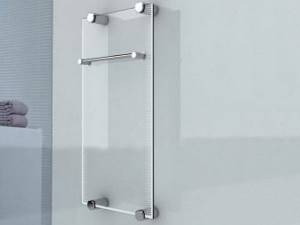
Film
A film heater is the thinnest wall-mounted heat source. It consists of a housing, infrared film and a cord with a plug. The body is made of fire-resistant material, on which a pattern is applied using thermal printing. The infrared film has a carbon coating. Outwardly it looks like a painting, which makes it more popular among designers. This device not only does not interfere with the interior, but somehow complements it. It is an absolutely fireproof heater. Its surface heats up to a maximum of 60 degrees Celsius, from which it is impossible to get a burn. The heating element of such a heater is made of a thin carbon filament, the thickness of which is 1.5 mm. The flexibility of this device allows it to be rolled into a tube shape and stored away for the summer. In this form they can be stored and transported. The lightness of the product makes it possible to hang the device on any surface, including doors and walls of different thicknesses.
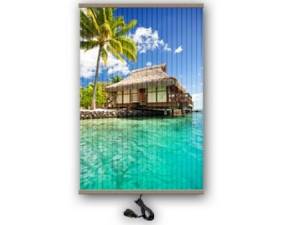
Determination and calculation of power
The heat output of an IR bathroom heater depends not on the size of the unit, but on its power. If the height of the room meets the standards, then by 10 sq.m. 1 kW of power will be required.
After determining the power, you can begin selecting a model. You should ask the seller whether the selected device is suitable for use in the bathroom, where there is high humidity and sudden temperature changes.
You also need to remember fire safety requirements.
You need to buy not just a beautiful heater, but choose it in accordance with the style of the room.

Device power rating
If heaters are the only source of heat in the room, then it is better to place them around the perimeter on the walls or ceiling. If an additional source is needed, it is recommended to install the device opposite the area where a person is most often located.
Before going to a specialty store, you need to calculate all the costs. Heating should be organized at the stage of repair work, then there will be no restrictions, and you can choose a unit that will fit into the interior and will work properly for a long time.
Average score of ratings is more than 0
Share link
Comments There are no comments yet, but you could be the first...
